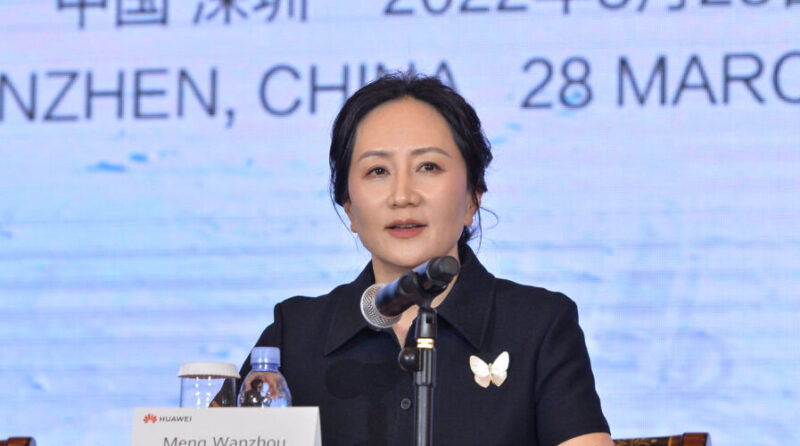China’s Huawei reports solid operations, future investments
China is steadily investing and exerting influence in ways that promote Libya’s eventual integration

Chinese telecoms company Huawei released its 2021 Annual Report today, revealing that the company had maintained solid operations throughout the past year. As per the report, Huawei achieved CNY636.8 billion in revenue in 2021, and CNY113.7 billion in net profits, an increase of 75.9% year-on-year.
The company’s R&D expenditure reached CNY142.7 billion in 2021, representing 22.4% of its total revenue, and bringing its total R&D expenditure over the past 10 years to over CNY845 billion. Moving forward, the company also plans to continuously increase investment in R&D.
Guo Ping, Huawei’s Rotating Chairman, stated at the press conference, “Overall, our performance was in line with forecast. Our carrier business remained stable, our enterprise business experienced steady growth, and our consumer business quickly expanded into new domains. In addition, we embarked on a fast track of ecosystem development.”
Meng Wanzhou, Huawei’s CFO, also spoke at the event, “Despite a revenue decline in 2021, our ability to make a profit and generate cash flows is increasing, and we are more capable of dealing with uncertainty.” Thanks to the enhanced profitability of its major businesses, the company’s cash flow from operating activities dramatically increased in 2021, amounting to CNY59.7 billion. Its liability ratio also dropped to 57.8%, and its overall financial structure has become more resilient and flexible.
In 2021, Huawei’s carrier business generated CNY281.5 billion in revenue and helped carriers around the world deploy leading 5G networks. Third-party test results have found that 5G networks built by Huawei for customers in 13 countries, including Switzerland, Germany, Finland, the Netherlands, South Korea, and Saudi Arabia, provide the best user experience. By working with carriers and partners, Huawei has signed more than 3,000 commercial contracts for industrial 5G applications. These kinds of 5G applications are currently seeing large-scale commercial use in sectors like manufacturing, mines, iron & steel plants, ports, and hospitals.
Thanks to continuing digital transformation trends, Huawei’s enterprise business also grew rapidly, generating CNY102.4 billion in revenue during 2021. In the past year, Huawei launched 11 scenario-based solutions for key sectors such as government, transportation, finance, energy, and manufacturing. The company also established multiple dedicated teams, including a Coal Mine Team, a Smart Road Team, and a Customs & Port Team, to combine resources in a way that more efficiently serves the needs of its customers. Over 700 cities and 267 Fortune Global 500 companies have chosen Huawei as their digital transformation partner and Huawei now works with more than 6,000 service and operation partners around the world.
Huawei’s consumer business zeroed in on consumer wants and needs, further building out the global ecosystem for a smart, all-connected era, as part of the company’s Seamless AI Life strategy for consumers around the world. This business generated CNY243.4 billion in revenue in 2021 and continued to see steady sales growth in smart wearables, smart screens, true wireless stereo (TWS) earbuds, and Huawei Mobile Services (HMS). In particular, the smart wearable and smart screen segments both saw 30%+ year-on-year growth. In total, HarmonyOS was used in over 220 million Huawei devices as of 2021, becoming the world’s fastest growing mobile device operating system.
During the past year, Huawei also focused on building out its openEuler, MindSpore, and HarmonyOS ecosystems based on the principles of open collaboration and shared growth. Over eight million developers are currently using Huawei’s open platforms, open-source software, and development tools to explore new business scenarios and business models.
Guo stressed, “Moving forward, Huawei will advance its journey of digitalization, intelligent transformation, and low carbon. Relying on talent, scientific research, and an innovative spirit, we will continuously increase investment to reshape our paradigms for fundamental theories, architecture, and software, and build our long-term competitiveness.”
All financial statements in the 2021 Annual Report were independently audited by KPMG, an international Big Four accounting firm.
What China is really up to in Libya?
In Libya, China’s strategy reinforces its regional, and even global, approach. China has managed to avoid becoming entangled in the conflict and, instead, poised itself to reap benefits no matter the outcome. Recognizing a possible win-win situation, China has hedged its bets.
China, by contrast, has already contrived influence in the Horn, leaving Beijing in a far less desperate position than other external actors who are still trying to secure their position in Africa.
For China, the Government of National Accord (GNA) was an attractive partner. The GNA was controling the Central Bank of Libya, giving it the ability to deploy funds, sign contracts, and distribute capital to partners, all of which are necessary for any viable partner for Beijing. For its part, the GNA has welcomed Chinese engagement, especially on areas like the upgrading and rebuilding of Libya’s infrastructure—an essential long-term concern for the GNA, evidenced by its embrace of China’s telecommunications companies, including Huawei and ZTE.
How to submit an Op-Ed: Libyan Express accepts opinion articles on a wide range of topics. Submissions may be sent to oped@libyanexpress.com. Please include ‘Op-Ed’ in the subject line.
- HoR-Backed Government moves to end fuel subsidy - December 26, 2024
- Libya and Algeria bolster customs cooperation - December 24, 2024
- Reports claim S-400, S-300 missiles moved to Libya - December 24, 2024


